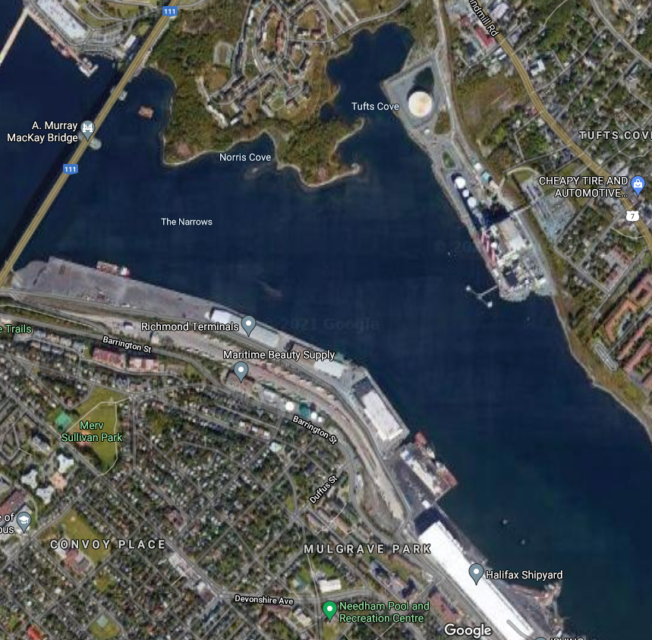World War Two
Published 27 Jul 2021“I said DAMN, this traffic jam … How I hate to be late, hurts my motor to go so slow. Time I get home my supper be cold. Damn, this traffic jam.” (James Taylor, the Eastern Front, 1942)
(more…)
July 28, 2021
How Hitler Created the World’s Worst Traffic Jam – WW2 – 152B – July 27, 1942
Possible relic from the 1917 Halifax explosion discovered by scuba diver
If you’re not familiar with the Halifax explosion, I collected some information about it here. One of the lesser-known ships involved in the disaster was the schooner St. Bernard, which was completely destroyed in the explosion of the cargo ship SS Mont Blanc after it collided with the Belgian relief ship Imo in the Narrows:

The schooner St. Bernard, which was destroyed when the Mont Blanc exploded nearby.
Photo from the Nova Scotia Museum.
A Halifax scuba diver has found something that could shed a little new light on one aspect of a dark chapter in Nova Scotian history.
Bob Chaulk has explored Halifax harbour from the Bedford Basin to Chebucto Head with hundreds of scuba dives over the last 30 years. But this spring, a routine dive in a small cove in the Narrows between Halifax’s two bridges led him to a big find.
Amid the usual assortment of scuttling crabs, polished bottles and bits of plastic trash, he came upon a huge, heavy object in Tufts Cove.
“When I first saw the anchor, I thought, OK, there’s a wreck here, some old derelict came in here. But there’s no way a ship that size could have gotten in here,” he said.
He explored until his air just about ran out. He estimated the anchor was about two metres long and weighed 135 kilograms. A ship that needed an anchor that size could not have sailed into shallow, rocky Tufts Cove, he thought.
So how did the old anchor get there?
He looked across the Narrows and found himself staring right at ground zero for the Halifax Explosion, which killed nearly 2,000 people. On Dec. 6, 1917, the vessel Imo and the Mont Blanc, a ship carrying explosive cargo, collided. The Mont Blanc caught fire and drifted into Pier 6, a space occupied today by the giant Halifax Shipyard building. The St. Bernard, a lumber schooner, was also at the dock.
“So now you have two ships side by side with a dock in between them. Here’s the Mont Blanc, here’s the Imo,” Chaulk said, showing the ships’ positions with his hands. “This one blows up, destroys this one, and I contend the anchor [of the St. Bernard] went through the air and landed right here.”

A modern day view of the Narrows, showing Tufts Cove to the north and the huge Halifax Shipyard complex on the south side of the channel.
Google Maps.
I suspect that the paved area to the right of the cove proper is largely landfill and the shoreline of 1917 probably followed much closer to the railway line.
H/T to Colby Cosh for the link.
Tank Chats #117 | Stridsvagn 103 | The Tank Museum
The Tank Museum
Published 5 Feb 2021Curator David Willey discusses the Cold War era Swedish Stridsvagn 103, also known as the ‘S-Tank’. Developed in the 1950s, the S-Tank was the first production tank to be powered by a turbine engine and it was also the only mass produced tank since the Second World War to not have a turret. A truly unconventional tank.
Support the work of The Tank Museum on Patreon: ► https://www.patreon.com/tankmuseum
Visit The Tank Museum SHOP & become a Friend: ► tankmuseumshop.orgTwitter: ► https://twitter.com/TankMuseum
Instagram: ► https://www.instagram.com/tankmuseum/
#tankmuseum #tanks
QotD: Lawrence and the Hejaz railway
Lawrence had used Aqaba as a base for repeated attacks on the Hejaz railway until the winter, when there was a lull in the fighting. Allenby’s progress towards Damascus was delayed, too, as two of his divisions (around 25,000 men) were redeployed to the Western Front. In the spring, when the drive to Damascus finally began, the policy towards the railway changed. It was imperative to cut off the line up from the Hejaz so that the Turks could not use it to bring reinforcements from Madinah against Allenby’s forces. Consequently, Lawrence’s group attacked the railway in various places, having developed a more sophisticated type of mine inappropriately called “tulip”. This was a much smaller charge, a mere 2lb of dynamite compared with the 40lb or 50lb ones used previously, and involved placing the charge underneath the sleepers, which would blow the metal upwards “into a tulip-like shape without breaking; by doing so it distored the two rails to which its ends were attached”, which was impossible to repair and consequently forced the Turks to replace the whole section of track. In early April 1918, the last train between Madinah and Damascus made it through but after that the line was blocked by successive attacks which left more Turkish troops stuck in the Hejaz protecting a line that was now of no strategic use than were facing Allenby in Palestine. In the decisvie attack at Tel Shahm, led by General Dawnay, Lawrence showed his regard for the railway by claiming the station bell, a fine piece of Damascus brass work: “the next man took the ticket punch and the third the office stamp, while the bewildered Turks stared at us with a growing indignation that their importance should be merely secondary”. The Turks had clearly never met any British trainspotters with their obsession for railway memorabilia.
Christian Wolmar, Engines of War: How Wars Were Won & Lost on the Railways, 2010.




